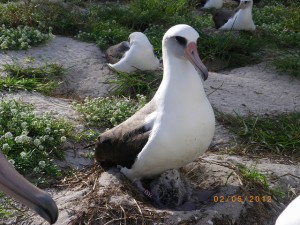Hardly anyone noticed an important occurrence this week on the tiny Pacific Atoll forever known to history as Midway, site of the most decisive naval battle of World War II. American military activity on the island was shut down about 20 years ago, and Congress made the deserted place a national wildlife refuge.
 This week something truly noteworthy happened. An albatross flew back to Midway for her annual mating, nesting, and hatching routine. Not for the first time, but for the 59th – that we know of. Turns out this particular bird, a Laysan albatross that wildlife officials named “Wisdom” (unbeknownst to her) is the world’s oldest known bird, at least 64 and probably older, still looking great and rearing young every year. How ironic that to have “an albatross around one’s neck” is to be cursed with a psychological burden, as the old literary metaphor goes.
This week something truly noteworthy happened. An albatross flew back to Midway for her annual mating, nesting, and hatching routine. Not for the first time, but for the 59th – that we know of. Turns out this particular bird, a Laysan albatross that wildlife officials named “Wisdom” (unbeknownst to her) is the world’s oldest known bird, at least 64 and probably older, still looking great and rearing young every year. How ironic that to have “an albatross around one’s neck” is to be cursed with a psychological burden, as the old literary metaphor goes.
Here is an interesting factoid – biologists have no idea how long birds might live. It turns out that they almost never grow old. Because it is almost impossible to follow individual birds their entire lives, the only data available comes from leg bands on a few that can be recaptured or photographed over several years. The rest is all educated guesswork. Generally, scientists have found that inexperienced young birds die the most, and the older they get, especially after successfully rearing young, the probability of death does not decrease but remains fairly constant. In other words, as a Stanford University study a few years ago found, they rarely die of old age. “They just run the same gamut of risks year in and year out until they are killed.” Nature can be cruel, especially if you are a bird. Some species have an annual kill rate as high as 70 percent, and some small songbirds have an adult life expectancy of only 10 months.
The U.S. Fish and Wildlife Service estimates that as many as a billion birds are killed every year in the U.S. by flying into buildings and other structures, and another 500 million are killed by wild cats. Predators and other “natural” causes result in the death of nearly 5 billion birds annually in the U.S. alone, or about 13.7 million every day. That makes the achievement of the albatross at Midway seem even more incredible. It has survived in one of the world’s least habitable places, lived through at least one hurricane that destroyed everything in sight (where it hid remains a mystery), and has somehow avoided predators for decades. Albatrosses don’t lay eggs until they are at least five years old, so we know this particular bird, banded in 1956, has been around almost since the close of the Korean War.
The few news items about the return of this special bird did not mention that there are hundreds of other albatrosses almost as old, many of whom were banded 30-40 years ago. But what especially caught my attention in these stories, and a government press release that prompted them, was the complete absence of any discussion whatsoever about the habitat on Midway. You see, designation as a National Wildlife Refuge was ironic, because there is absolutely nothing remotely close to natural habitat left there. The entire place was denuded of vegetation, paved over with runways and buildings, heavily bombed by enemy warplanes – a complete mess.
Midway Atoll consists of two miniscule islands totaling two square miles. Eastern Island is still almost entirely paved over by three runways, now closed but still there. Sand Island also still has three old runways, one still in use (by wildlife officials), and is heavily dotted with old buildings and lots of trash left behind by decades of uses more urgent than preserving bird habitat. Yet today those tiny islands are home to 70 percent of the world’s entire population of Laysan albatrosses, which return every year no matter what people are doing, almost darkening the entire place with the hatching of thousands of brown chicks.
The reason habitat is not discussed in stories about the Laysan albatross is that this story does not fit the popular narrative, namely that the activities of mankind always destroy habitat, and that man and nature are always in conflict. Of course, the truth is that nature is incredibly adaptable, and many species have learned to live – and thrive – amidst human activity. “Wisdom” is proof of that, so perhaps we should stop demonizing all human activity, and remove that albatross from our necks.
(A version of this column originally appeared in the Grand Junction Daily Sentinel December 4, 2015.)




Comments on this entry are closed.